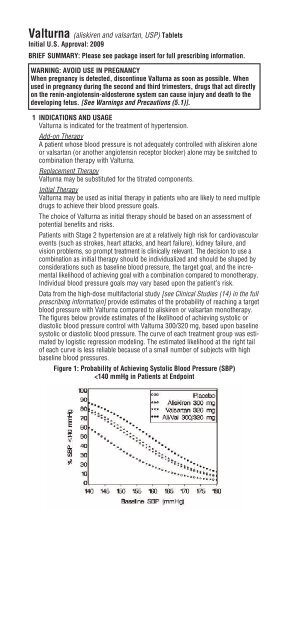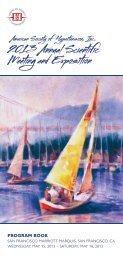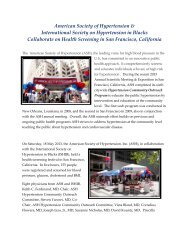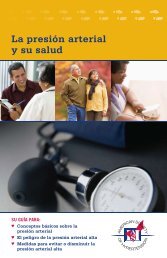2010 Annual Scientific Meeting and Exposition 2010 Annual ...
2010 Annual Scientific Meeting and Exposition 2010 Annual ...
2010 Annual Scientific Meeting and Exposition 2010 Annual ...
You also want an ePaper? Increase the reach of your titles
YUMPU automatically turns print PDFs into web optimized ePapers that Google loves.
Valturna (aliskiren <strong>and</strong> valsartan, USP) TabletsInitial U.S. Approval: 2009BRIEF SUMMARY: Please see package insert for full prescribing information.WARNING: AVOID USE IN PREGNANCYWhen pregnancy is detected, discontinue Valturna as soon as possible. Whenused in pregnancy during the second <strong>and</strong> third trimesters, drugs that act directlyon the renin-angiotensin-aldosterone system can cause injury <strong>and</strong> death to thedeveloping fetus. [See Warnings <strong>and</strong> Precautions (5.1)].1 INDICATIONS AND USAGEValturna is indicated for the treatment of hypertension.Add-on TherapyA patient whose blood pressure is not adequately controlled with aliskiren aloneor valsartan (or another angiotensin receptor blocker) alone may be switched tocombination therapy with Valturna.Replacement TherapyValturna may be substituted for the titrated components.Initial TherapyValturna may be used as initial therapy in patients who are likely to need multipledrugs to achieve their blood pressure goals.The choice of Valturna as initial therapy should be based on an assessment ofpotential benefits <strong>and</strong> risks.Patients with Stage 2 hypertension are at a relatively high risk for cardiovascularevents (such as strokes, heart attacks, <strong>and</strong> heart failure), kidney failure, <strong>and</strong>vision problems, so prompt treatment is clinically relevant. The decision to use acombination as initial therapy should be individualized <strong>and</strong> should be shaped byconsiderations such as baseline blood pressure, the target goal, <strong>and</strong> the incrementallikelihood of achieving goal with a combination compared to monotherapy.Individual blood pressure goals may vary based upon the patient’s risk.Data from the high-dose multifactorial study [see Clinical Studies (14) in the fullprescribing information] provide estimates of the probability of reaching a targetblood pressure with Valturna compared to aliskiren or valsartan monotherapy.The figures below provide estimates of the likelihood of achieving systolic ordiastolic blood pressure control with Valturna 300/320 mg, based upon baselinesystolic or diastolic blood pressure. The curve of each treatment group was estimatedby logistic regression modeling. The estimated likelihood at the right tailof each curve is less reliable because of a small number of subjects with highbaseline blood pressures.Figure 1: Probability of Achieving Systolic Blood Pressure (SBP)









